The Silver Eggheads by Fritz Leiber
Fritz Leiber is one of the grand names of f&sf, winner of six Hugo Awards, three Nebula Awards, and two World Fantasy Awards. He is a member of the SF Hall of Fame, a SFWA Grandmaster, and a lifetime achievement recipient from the World Fantasy, Bram Stoker, and Forry Awards. You wouldn’t think any novel of his from the epicenter of his career could be obscure, neglected, or forgotten. And yet, there’s the case of The Silver Eggheads.
As a novelet, “The Silver Eggheads” graced the cover of the January 1959 F&SF, normally as prestigious a slot available at the time. Yet the story has never been anthologized nor ever included in one of his three dozen collections. Possibly that’s because Leiber expanded it to novel length, published as an original paperback by Ballantine in 1962. (Yes, that is a Richard Powers cover, one of the few representational ones he did.) Ballantine reprinted it twice, but no other American publisher has touched it. This novel has been out of print in English for almost 40 years. A few foreign editions slipped in, for multilinguists and obsessive collectors.
I wish I could recommend it as a great lost classic of the field. It is not. It’s only value today is that it is so. damn. weird. Part in-joke, part rant against cheaply written genre, part critique of sexual repression, part mental masturbation, The Silver Eggheads is a showy, wordy explosion of the id in a decade when science fiction writers who wanted to break out of the prison of genre might well have felt they were imprisoned brains.
Writers are worshiped heroes two centuries in the future, a premise so implausible that it must be science fiction. Families come to witness them at their fabled wordmills, two-story tall computers that output the omni-popular wordwooze, smooth bestselling writing that gratifies like an amyl nitrate popper, to be used only once and literally impossible to reread, thereby guaranteeing a steady inexhaustible need for new product. What the public doesn’t know is that writers merely dust the machines, who are programmed by publishers’ editorial directors. Fortuitously, every wordmill in the solar system lies on Readership Row in New Angeles. The writers union revolt takes them all out in a single strike, leaving the writers free to do what they’ve always wanted to do. Write. Except that having spent their entire lives not writing, they have no idea how to start.
The publishers are equally devastated, except those at Rocket House, “pronounced Racket House by the cognoscenti.” They harbor a secret. Two centuries earlier, in the mid-1950s to be precise, a “virtuoso surgeon and electronics genius” scraped the brains out of 30 genius writers (after their death – this isn’t horror) and made them immortal inside gleaming silver ovoids where they would finally be released to do nothing but think. A succession of nurses have tended them ever since. Now is the time to get their thoughts on paper. (Of course, paper is still used. You think this is the future or something?)
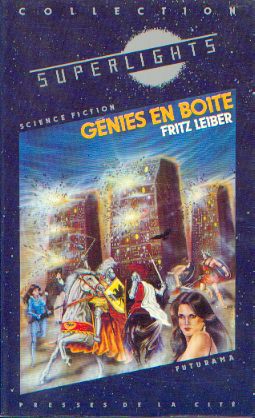 |
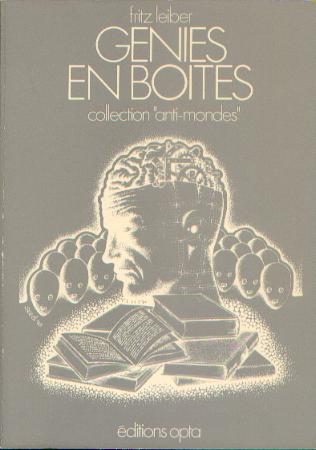 |
Immediately all hell breaks loose, substituting for a plot. The writers think that anti-union finks are behind this. The other publishers hire a goon. The Feds send in an undercover man. The Penfolk are a squad of old ladies who have been privately publishing their poems for eternity. The interplanetary gangster known as the Garotte sees an opportunity. A professional book-hijacker wants to steal whatever undistributed books remain. And Cain Brinks, robot adventure-author, thinks his rival Zane Gort, of the bestselling Dr. Tungsten Reams a Nut, is plotting to become the czar of human fiction.
Robots? Yes, this is a robot novel, in some ways the ur-robot novel. Leiber wants to talk about sexual pervasions and Freudian impulses and sheer sensual immersion in the world of experience as the bases of creativity and can’t do so in his era without sublimating that into robots.
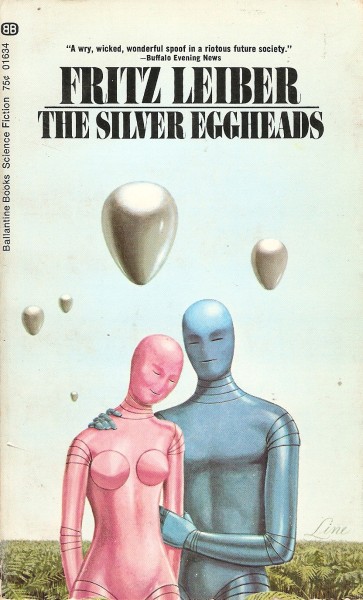 |
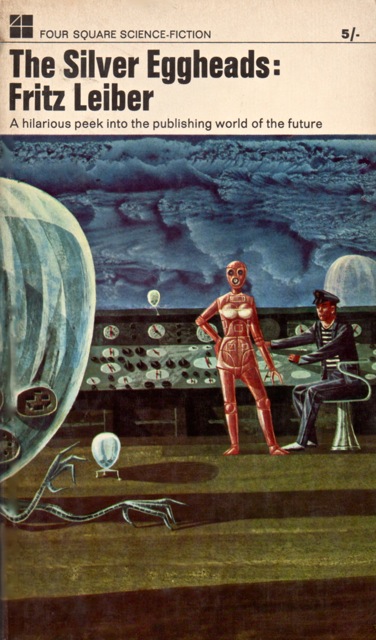 |
Robots are therefore the real heroes of The Silver Eggheads. They retain the values that human beings have lost and could theoretically regain, as the robots had. Their early models “almost invariably suffered from melancholia and involutional psychosis.” But a robot who was reading to her mistress Isaac Asimov’s I, Robot experienced an almost religious “healing rush of relief.” That lead to robot authors writing for robot readers and a reverence for stimulating their brains. “We robots know how to value consciousness, perhaps because it came to us all at once, miraculously, and we would no more dull it with wordwooze than we would burn out our circuits for kicks,” Gort says.
Kicks are all that humans care for, naturally. They interrupt the spiritual tale for an explanation of how robots, who are built brunch and ixy, in male and female analogues, in gray steel and pink aluminum, have sex. Gort is appalled.
“How like humans. The universe is vast, majestic, intricate, patterned with inexhaustible beauty, vivid with infinitely varied life – and there’s only one thing in it that really interests you. The same thing that makes you buy books, build families, create atomic theories (I imagine) or, once upon a time, write poetry. Sex.”
Gort’s disdain is more than somewhat undercut by his panting after Miss Blushes, an ixy, a pink aluminum government censor robot who corrects any mention of “knew,” even in speech, with “was acquainted with.” She serves as a reminder of the priggishness and bowdlerization of science fiction in the 1950s, although an official censor is undermined by the wordmills also turning out pornography. And that while Gort is the true hero of the story, she is a moronic stereotype who turns out to be hot in bed, just like those prudish types always are. Continuity here is violated almost as often as on, say, The Jetsons.
You don’t want to hear that. Your filthy imagination has been panting impatiently, waiting for me to tell you how robots do do it. They plug into one another, of course. Newer models have as many as 33 connections.
While you ponder that image, try this paragraph:
“Can you imagine, Flaxy, having it with a girl who is all velvet or plush, or who can softly sing you a full-orchestra symphony while you’re doing it or maybe Ravel’s Bolero, or who has slightly – not excessively – prehensile breasts or various refreshingly electric skin areas, or who has some of the features – not overdone, of course – of a cat or a vampire or an octopus, or who has hair like Medusa’s or Shambleau’s that lives and caresses you, or who has four arms like Siva, or a prehensile tail eight feet long … and at the same time is perfectly safe and can’t bother or involve or infect or dominate you in any way? I don’t want to sound like a brochure, Flexy, but believe me, it’s the ultimate!”
The sexbot originates here. Not the idea of a sexbot nor the idea of sex between a human and a robot or whatever happens offpage in “Helen O’Loy” you with your filthy imagination. The book offers down and dirty pre-Westworld robot prostitutes in humanoid skin and nipples that dispense chocolate and peppermint, beating “Dean Hudson’s” The Robot Lovers to print by four years. Leiber undercuts himself again with an excessively – not slightly – straight male fantasy image of, as he calls them, femmequins. If it helps, Flaxy likes being dominated, in fact being beaten and tortured, BDSM-style, by women. The strongest character is the book is a woman writer, who puts on a necklace of skulls when she hunts down her men, wants sex three hours at a time, and is prone to faceslapping her prey. She’s also the head of the striking unionists and the only one besides Gort who has two brains cells to rub together. Every time you want to throw the book at a wall, Leiber zigs and surprises you.
None of the interminable lectures on sex were in the novelet version; they could not be. That’s clearly why Leiber expanded his already overwrought original, a florid and woozy word howl at the clean cut engineers and asexual planet-hoppers that dominated the field of science fiction, in which psychiatry was derided by Dianetics, and ordinary human sexual feelings, let alone those of robots, were carefully expurgated, where prose without any stylistic idiosyncrasies was praised as the highest achievement, and outsiders simply assumed, for historically true reasons, that the best of it sounded something like this.
On and on the Golden Horse surged, perching on planets, bivouacking on galaxies. Here and there, on scattered systems, resistance flared. But space spears flashed and klirred mercilessly and that resistance died.
Ittala, High Khan of the Golden Swarm, called for his super-telescope. It was borne into the blood-stained pavilion by cringing scientists. He snatched it up … and directed it at a planet in a far-distant galaxy that had as yet escaped the yellow marauders.
Slaver poured from the High Khan’s beak and ran down his tentacles. He dug an elbow into fat Ik Huk, Master of the Harem. “That one,” he hissed, “the one in the middle of the bevy on the grass knoll, the one wearing the radium tiara, bring her to me!
Never mind that this is supposedly an example from the slush pile from amateurs who still[!] send in manuscripts despite the wordmills, it reproduces the heavy weight of adolescent superscience that was part of recent memory inside science fiction and elsewhere, preventing it from ever rising to literary acceptance. (And maybe inspired Leia’s bikini scene.) Not that the brainy superannuated writers are better. With 200 years of living in their heads, devoid of experience, and carefully kept away from all popular culture, they write puzzles instead of stories. “Ulysses, Mars Violet, Alexanderplatz, Venus Deferred, The Fairy Queen, and the riddling Icelandic bards aren’t in it for sheer perverse complexity.”
What the writers need is the humanity that the robots have evolved. As one says:
I exist in a darkness compared to which that of intergalactic space is brightest light. You treat me like a bright child, and I’m not a child. I’m an ancient on the edge of death and I’m a baby in the womb – and more and less than either of those. We discarnates are not geniuses, we’re madmen and gods. … Our loneliness is beyond your understanding.
Heavy. This would be a great moral ending for the book, were it not that it comes in the introduction to the Eggheads, who thereafter are portrayed like a middle school full of mean tweens, gossiping, backstabbing, and ignoring those who offend for years at a time. Leiber wrote this book for himself, not for any readers. Apparently he wrote it a page at a time, chuckled inwardly, and then wrote another page for another reason, finally shuffling the whole mess into a manuscript. The book is an example of the pornography of indulgence. Does he indulge himself with a page of robot writing? Of course he does.
Clinch, clinch, clinch went the bost working pinchers, firming the cable to the streamlined silfish burden. Squinch, squinch, squinch went to the winch as Dr. Tungsten turned it. A feelingful flood rilled the grills of his brunch frame. “Happy landings,” he gusted softly, “happy landings, my golden darling.”
His readers, you see, love cranking scenes almost as much as humans love spanking scenes. (His words, not mine. Hmm. Can robots masturbate?) The eggheads prefer it to wordwooze. (How the translators handled that is mysterious. Perhaps they left it in English and went in relief to Ulysses.) Of course, one more time – the entire novel is an exercise in “of course” interspersed with “huh?”, we never ever get as much as a participial phrase of wordwooze.
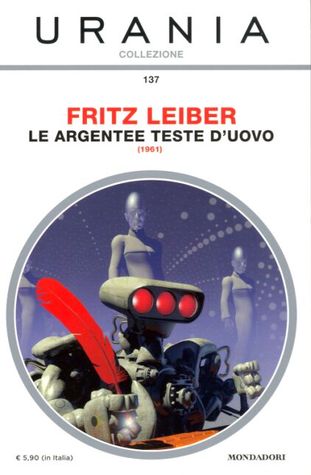 |
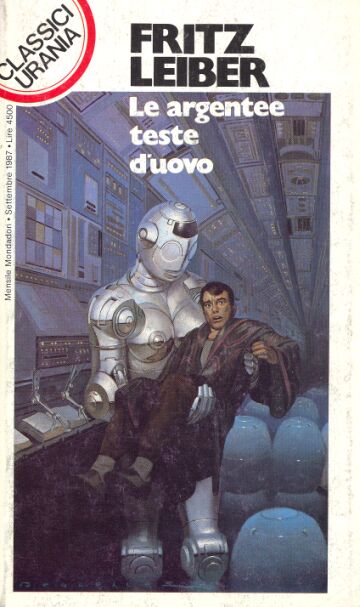 |
The Silver Eggheads is many things, most of them terrible, but perhaps best thought of as the rare book that spans the dizzying abyss between the Golden Age and the New Wave, having elements of each clashing against one another like bent cogs. Such a cyborg is perhaps proof of why halflings are tossed from both communities. Yet our field is full of tales of halflings succeeding against all odds. We tend to like halflings; they are us, burdened with love for the fantastic and the mundane, for the high and the low, for the subtle and the flamboyant, for cheap thrills and great art. Leiber wrote this book between masterpieces. He was as torn as us. As we shall always be.
Steve Carper writes for The Digest Enthusiast; his story “Pity the Poor Dybbuk” appeared in Black Gate 2. His website is flyingcarsandfoodpills.com. His last article for us was The Mighty Electric Men.
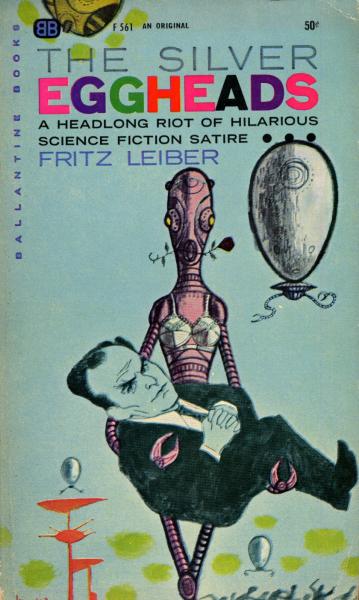
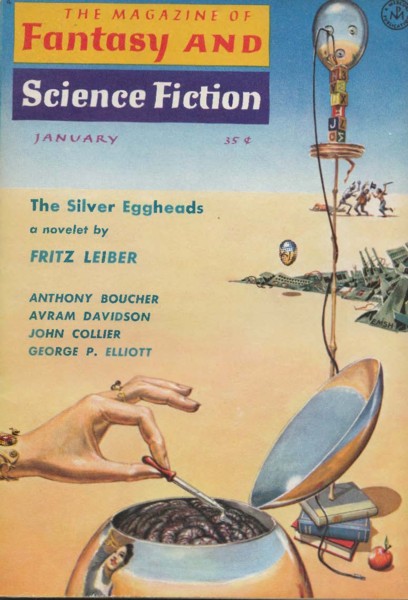
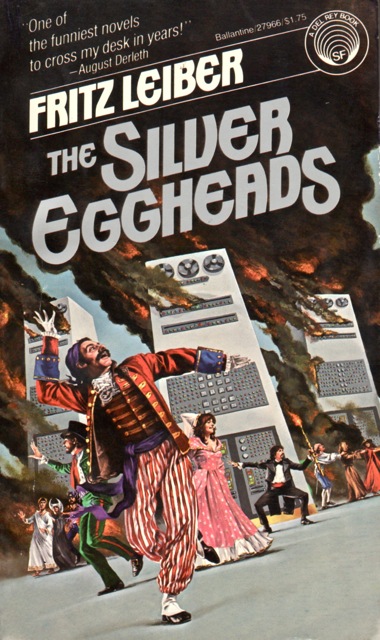
Yeah, thanks for the good warning. It seems to me that Leiber’s an author who wrote a handful of stories that stick in mind as favorites, and then a lot of stuff that disappoints.
Major,
I think Leiber’s hit rate was generally a lot higher than most. Anyone can have an off book or two.
And who knows? Maybe THE SILVER EGGHEADS will be a rediscovered classic in our coming era of machine dominance.
John, I read quite a lot of Leiber back in the Seventies, but a few short stories and the You’re All Alone novella (I read it and reread in a late-1960s Fantastic!) are about all that, for me, holds up. The Fafhrd-Mouser stories tend now, for me, to be like work of another author I used to like a lot more, Lord Dunsany; the inconsequentiality and knowingness suggest rather too strongly the presence of an author who is just amusing himself. This kind of clever-clever writing is really appealing when you’re a smart adolescent misfit; later on, not so much….
Someone as prolific in so many modes and genres over so many years is bound to have some stuff – probably a lot – that’s not going to hold up. Certainly some of leiber’s output falls in that category – even some of his “high reputation” things. (I’ve always thought The Big Time was overrated.)
But there are so many great things, not least of which are two of the best horror novels I’ve ever read, Conjure Wife and Our Lady of Darkness. I think his sword and sorcery is still worthwhile, and The Wanderer is a terrific example of wide-screen disaster sf, and a parody of it at the same time.
And he wrote a short story, “Mariana,” so brilliant and chilling it leaves me speechless every time I read it.
His place is well assured, I think.
I went to look up “Mariana” and found it in Merril’s 5th Best SF. In the intro she wrote that her very first selection for the anthology had been “The Silver Eggheads,” but she couldn’t resist “Mariana.” Well, I’d make the same choice every time. As I read robot stories I found that Leiber did a lot of work in what might be called the gonzo mode in the pre-New Wave area. “A Bad Day for Sales” is amazing for 1953 and “The Creature from Cleveland Depths” (1962) is the best forecast of our smartphone dependent society ever made. If he had only known about miniaturization…
Thanks for digging up this odd, obscure book! Was very interesting to read about it, although probably less so to read it…
I think this is one of Leiber’s best, precisely because it is so weird.
Re the “robot writing”: that’s a parody of porny writing, written by a guy who’d had one of his classic existential-horror novels repackaged as a spank-book by a sleazy publisher. Personally I think it’s super-funny, but de gustibus non disputandum.
Likewise the use of sexbots for extortion, the poseurs of various kinds that float around the extremely businesslike business of writing, the robot romance, the reversals of fortunes among all the very cartoony characters.
Not trying to talk anyone into anything, just representing. FL is three to five of the best sf/f writers, in my view, and this book has aged a lot better than, say, The Wanderer or even Gather, Darkness!.
BTW, does anyone have an idea who the man on the original novel cover at top might be? I thought at first Ian Ballantine but the pictures I found don’t resemble the cover.
Yes Steve, it sure is Ian Ballantine! I own the original painting and got it from Ian and Betty’s estate. I also have the book cover art she was portrayed on as well called Starchild by Pohl and Williamson done by the adult magazine art Bill Edwards.